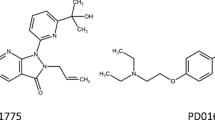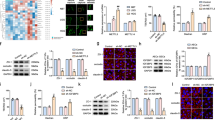Abstract
Low delivery of many anticancer drugs across the blood–brain barrier (BBB) is a limitation to the success of chemotherapy in glioblastoma. This is because of the high levels of ATP-binding cassette transporters like P-glycoprotein (Pgp/ABCB1), which effluxes drugs back to the bloodstream. Temozolomide is one of the few agents able to cross the BBB; its effects on BBB cells permeability and Pgp activity are not known. We found that temozolomide, at therapeutic concentration, increased the transport of Pgp substrates across human brain microvascular endothelial cells and decreased the expression of Pgp. By methylating the promoter of Wnt3 gene, temozolomide lowers the endogenous synthesis of Wnt3 in BBB cells, disrupts the Wnt3/glycogen synthase kinase 3/β-catenin signaling, and reduces the binding of β-catenin on the promoter of mdr1 gene, which encodes for Pgp. In co-culture models of BBB cells and human glioblastoma cells, pre-treatment with temozolomide increases the delivery, cytotoxicity, and antiproliferative effects of doxorubicin, vinblastine, and topotecan, three substrates of Pgp that are usually poorly delivered across BBB. Our work suggests that temozolomide increases the BBB permeability of drugs that are normally effluxed by Pgp back to the bloodstream. These findings may pave the way to new combinatorial chemotherapy schemes in glioblastoma.







Similar content being viewed by others
Abbreviations
- GBM:
-
Glioblastoma multiforme
- CNS:
-
Central nervous system
- BBB:
-
Blood–brain barrier
- TMZ:
-
Temozolomide
- ABC:
-
ATP-binding cassette
- BAT:
-
Brain-adjacent to tumor
- Pgp:
-
P-glycoprotein
- MRP:
-
Multidrug resistance-related protein
- BCRP:
-
Breast cancer resistance protein
- LRP:
-
Low-density lipoprotein receptor-related protein
- GSK3:
-
Glycogen synthase kinase 3
- TCF/lEF:
-
T cell factor/lymphoid enhancer factor
- Dkk-1:
-
Dickkopf-1
- HBMECs:
-
Human brain microvascular endothelial cells
- FCS:
-
Fetal calf serum
- BSA:
-
Bovine serum albumin
- FITC:
-
Fluorescein isothiocyanate
- ZO-1:
-
Zonula occludens-1
- TBP:
-
TATA-box binding protein
- qRT-PCR:
-
Quantitative real-time PCR
- ChIP:
-
Chromatin immunoprecipitation
- MSP:
-
Methylation-specific PCR
- DAPI:
-
4′,6-Diamidino-2-phenylindole dihydrochloride
- LDH:
-
Lactate dehydrogenase
References
Bai RY, Staedke V, Riggins GJ (2011) Molecular targeting of GBM: drug discovery and therapies. Trends Mol Med 17:301–332
Serwer LP, James CD (2012) Challenges in drug delivery to tumors of the central nervous system: an overview of pharmacological and surgical considerations. Adv Drug Deliv Rev 64:590–597
Saleem A, Brown GD, Brady F, Aboagye EO, Osman S, Luthra SK, Ranicar AS, Brock CS, Stevens MF, Newlands E, Jones T, Price P (2003) Metabolic activation of temozolomide measured in vivo using positron emission tomography. Cancer Res 63:2409–2415
Wick W, Plattan M, Weller M (2009) New (alternative) temozolomide regimens fort he treatment of glioma. Neuro Oncol 11:69–79
Vredenburgh JJ, Desjardins A, Reardon DA, Peters KB, Herndon JE 2nd, Marcello J, Kirkpatrick JP, Sampson JH, Bailey L, Threatt S, Friedman AH, Bigner DD, Friedman HS (2011) The addition of bevacizumab to standard radiation therapy and temozolomide followed by bevacizumab, temozolomide, and irinotecan for newly diagnosed glioblastoma. Clin Cancer Res 17:4119–4124
Lopez KA, Tannenbaum AM, Assanah MC, Linskey K, Yun J, Kangarlu A, Gil OD, Canoli P, Bruce JN (2011) Convection-enhanced delivery of topotecan into PDGF-driven model of glioblastoma prolongs survival and ablates both tumor-initiating cells recruited glial progenitors. Cancer Res 71:3963–3971
Hau P, Fabel K, Baumgart U, Rummele P, Grauer O, Bock A, Dietmaier C, Dietmaier W, Dietrich J, Dudel C, Hubner F, Jaucj T, Drechsel E, Kleiter I, Wismeth C, Zellner A, Brawanski A, Steinbrecher A, Marienhagen J, Bogdahan U (2004) PEGylated liposomal doxorubicin-efficacy in patients with recurrent high-grade glioma. Cancer 100:1199–1207
Agarwal S, Sane R, Oberoi R, Ohlfest JR, Elmquist WF (2011) Delivery of molecularly targeted therapy to malignant glioma, a disease of the whole brain. Expert Rev Mol Med 13:e17
Guillaume DJ, Doolittle ND, Gahramanov S, Hedrick NA, Delashaw JB, Neuwelt EA (2010) Intra-arterial chemotherapy with osmotic blood–brain barrier disruption for aggressive oligodendroglial tumors: results of a phase I study. Neurosurgery 66:48–58
Liu H-L, Hua M-Y, Chen P-Y, Chu P-C, Pan C-H, Yang H-W, Wuang C-Y, Wang J-J, Yen T-C, Wei K-C (2010) Blood–brain barrier disruption with focused ultrasound enhanced delivery of chemotherapeutic drugs for glioblastoma treatment. Radiology 255:415–425
Agarwal S, Hartz AM, Elmquist WF, Bauer B (2011) Breast cancer resistance protein and P-glycoprotein in brain cancer: two gatekeepers team up. Curr Pharm Des 17:2793–2802
Poller B, Drewe J, Krähenbühl S, Huwyler J, Gutmann H (2010) Regulation of BCRP (ABCG2) and P-glycoprotein (ABCB1) by cytokines in a model of the human blood–brain barrier. Cell Mol Neurobiol 30:63–70
Chan GNY, Hoque MT, Cummins CL, Bendayan R (2011) Regulation of P-glycoprotein by orphan nuclear receptors in human brain microvessel endothelial cells. J Neurochem 118:163–175
Wang X, Hawkins BT, Miller DS (2011) Aryl hydrocarbon receptor-mediated up-regulation of ATP-driven xenobiotic efflux transporters at the blood–brain barrier. FASEB J 25:644–652
Daneman R, Agalliu D, Zhoy L, Kuhnert F, Kuo CJ, Barres BA (2009) Wnt/β-catenin signalling is required for CNS, but not non-CNS, angiogenesis. Proc Natl Acad Sci USA 106:641–646
Liebner S, Plate KH (2010) Differentiation of the brain vasculature: the answer came blowing by the Wnt. J Angiogenes Res 2:1–10
Lim JC, Kania KD, Wijesuriya H, Chawla S, Sethi JK, Pulaski L, Romero IA, Couraud PO, Weksler BB, Hladky SB, Barrand MA (2008) Activation of β-catenin signalling by GSK-3 inhibition increases p-glycoprotein expression in brain endothelial cells. J Neurochem 106:1855–1865
Kania KD, Wijesuriya HC, Hladky SB, Barrand MA (2011) Beta amyloid effects on expression of multidrug efflux transporters in brain endothelial cells. Brain Res 1418:1–11
Flahaut M, Meier R, Coulon A, Nardou KA, Niggli FK, Martinet D, Beckmann JS, Joseph J-M, Muhlethaler-Mottet A, Gross N (2009) The Wnt receptor FZD1 mediates chemoresistance in neuroblastoma through activation of the Wnt/b-catenin pathway. Oncogene 28:2245–2256
Schaich M, Kestel L, Pfirrmann M, Robel K, Illmer T, Kramer M, Dill C, Ehninger G, Schackert G, Krex D (2009) A MDR1 (ABCB1) gene single nucleotide polymorphism predicts outcome of temozolomide treatment in GBM patients. Ann Oncol 20:175–181
Weksler BB, Subileau EA, Perrière N, Charneau P, Holloway K, Leveque M, Tricoire-Leignel H, Nicotra A, Bourdoulous S, Turowski P, Male DK, Roux F, Greenwood J, Romero IA, Couraud PO (2005) Blood–brain barrier-specific properties of a human adult brain endothelial cell line. FASEB J 19:1872–1874
Monnaert V, Betbeder D, Fenart L, Bricout H, Lenfant AM, Landry C, Cecchelli R, Monflier E, Tilloy S (2004) Effects of γ- and hydroxy propyl- γ -cyclodextrins on the transport of doxorubicin across an in vitro model of blood–brain barrier. J Pharmacol Exp Ther 311:1115–1120
Siflinger-Birnboim A, Del Vecchio PJ, Cooper JA, Blumenstock FA, Shepard JM, Malik AB (1987) Molecular sieving characteristics of the cultured endothelial monolayer. J Cell Physiol 132:111–117
Campia I, Gazzano E, Pescarmona G, Ghigo D, Bosia A, Riganti C (2009) Digoxin and ouabain increase the synthesis of cholesterol in human liver cells. Cell Mol Life Sci 66:1580–1594
Broadley KW, Hunn MK, Farrand KJ, Price KM, Grasso C, Miller RJ, Hermans IF, McConnell MJ (2011) Side population is not necessary or sufficient for a cancer stem cell phenotype in glioblastoma multiforme. Stem Cells 29:452–461
Liu Y, Yang G, Bu X, Liu G, Ding J, Li P, Jia W (2011) Cell-type-specific regulation of raft-associated Akt signalling. Cell Death Dis 2:e145
Carcaboso AM, Elmeliegy MA, Shen J, Juel SJ, Zhang ZM, Calabrese C, Tracey L, Waters CM, Stewart CF (2010) Tyrosine kinase inhibitor gefitinib enhances topotecan penetration of gliomas. Cancer Res 70:4499–4508
Kopecka J, Campia I, Olivero P, Pescarmona G, Ghigo D, Bosia A, Riganti C (2011) A LDL-masked liposomal-doxorubicin reverses drug resistance in human cancer cells. J Contr Rel 149:196–205
Pinzón-Daza ML, Garzón R, Couraud PO, Romero IA, Weksler B, Ghigo D, Bosia A, Riganti C (2012) The association of statins plus LDL receptor-targeted liposome-encapsulated doxorubicin increases the in vitro drug delivery across blood–brain barrier cells. Brit J Pharmacol 167:1431–1447
Portnow J, Badie B, Chen M, Liu A, Blanchard S, Synold TW (2009) The neuro-pharmacokinetics of temozolomide in patients with resectable brain tumors: potential implications for the current approach to chemoradiation. Clin Cancer Res 15:7092–7098
Dalmark M, Storm HH (1981) A Fickian diffusion transport process with features of transport catalysis. Doxorubicin transport in human red blood cells. J Gen Physiol 78:349–364
Ito S, Woodland C, Sarkadi B, Hockmann G, Walker SE, Koren G (1999) Modeling of P-glycoprotein-involved epithelial drug transport in MDCK cells. Am J Physiol 277:F84–F96
Goodwin AM, Sullivan KM, D’Amore PA (2006) Cultured endothelial cells display endogenous activation of the canonical Wnt signalling pathway and express multiple ligands, receptors, and secreted modulators of Wnt signalling. Dev Dyn 235:3110–3120
Fu L, Zhang C, Zhang LY, Dong SS, Lu LH, Chen J, Dai Y, Li Y, Kong KL, Kwong DL, Guan XY (2011) Wnt2 secreted by tumor fibroblasts promotes tumor progression in oesophageal cancer by activation of the Wnt/β-catenin signalling pathway. Gut 60:1635–1643
Liebner S, Corada M, Bangsow T, Babbage J, Taddei A, Czupalla CJ, Reis M, Felici A, Wolburg H, Fruttiger M, Taketo MM, von Melchner H, Plate KH, Gerhardt H, Dejana E (2008) Wnt/beta-catenin signalling controls development of the blood–brain barrier. J Cell Biol 183:409–417
Bernardi H, Gay S, Fedon Y, Vernus B, Bonnieu A, Bacou F (2011) Wnt4 activates the canonical β-catenin pathway and regulates negatively myostatin: functional implication in myogenesis. Am J Physiol Cell Physiol 300:C1122–C1138
Tai LM, Loughlin AJ, Male DK, Romero IA (2009) P-glycoprotein and breast cancer resistance protein restrict apical-to-basolateral permeability of human brain endothelium to amyloid-β. J Cereb Blood Flow Metab 29:1079–1083
Park CH, Chang JY, Hahn ER, Park S, Kim HK, Yang CH (2005) Quercetin, a potent inhibitor against beta-catenin/Tcf signalling in SW480 colon cancer cells. Biochem Biophys Res Commun 328:227–234
Zhang H, Zhang Z, Wu X, Li W, Su W, Su P, Cheng H, Xiang L, Gao P, Zhou G (2012) Interference of Frizzled 1 (FD1) reverses multidrug resistance in breast cancer cells through the Wnt/β-catenin pathway. Cancer Lett 323:106–113
Ananda S, Nowak AK, Cher L, Dowling A, Brown C, Simes J, Rosenthal MA, Cooperative Trials Group for Neuro-Oncology (COGNO) (2011) Phase 2 trial of temozolomide and PEGylated liposomal doxorubicin in the treatment of patients with glioblastoma multiforme following concurrent radiotherapy and chemotherapy. J Clin Neurosci 18:1444–1448
Steiniger SC, Kreuter J, Khalansky AS, Skidan IN, Bobruskin AI, Smirnova ZS, Severin SE, Uhl R, Kock M, Geiger KD, Gelperina SE (2004) Chemotherapy of glioblastoma in rats using doxorubicin-loaded nanoparticles. Int J Cancer 109:759–767
Wohlfart S, Khalansky AS, Gelperina S, Begley D, Kreuter J (2011) Kinetics of transport of doxorubicin bound to nanoparticles across the blood–brain barrier. J Control Rel 154:103–107
Yount G, Yang Y, Wong B, Wang H-J, Yang L-X (2007) A novel camptothecin analog with enhanced antitumor activity. Anticancer Res 27:3173–3178
Acknowledgments
We are indebted to Prof. Michele Lanotte (Department of Neuroscience, Neurosurgical Unit, University of Turin) and to Dr. Rossella Galli (San Raffaele Scientific Institute, Milan) for providing the primary glioblastoma samples. We are grateful to Costanzo Costamagna (Department of Oncology, University of Turin) for the technical assistance and to Dr. Oriana Monzeglio (Neuro-bio-oncology Center, Policlinico di Monza Foundation) for the technical suggestions with methylation promoter assay. This work has been supported by grants from Compagnia di San Paolo, Italy (Neuroscience Program; grant 2008.1136) and Italian Association for Cancer Research (AIRC; MFAG 11475) to Chiara Riganti. Martha Leonor Pinzón-Daza is recipient of a ERACOL Erasmus Mundus fellowship. Joanna Kopecka is recipient of a “Mario and Valeria Rindi” fellowship provided by Italian Foundation for Cancer Research (FIRC).
Conflict of interest
None.
Author information
Authors and Affiliations
Corresponding author
Electronic supplementary material
Below is the link to the electronic supplementary material.
Rights and permissions
About this article
Cite this article
Riganti, C., Salaroglio, I.C., Pinzòn-Daza, M.L. et al. Temozolomide down-regulates P-glycoprotein in human blood–brain barrier cells by disrupting Wnt3 signaling. Cell. Mol. Life Sci. 71, 499–516 (2014). https://doi.org/10.1007/s00018-013-1397-y
Received:
Revised:
Accepted:
Published:
Issue Date:
DOI: https://doi.org/10.1007/s00018-013-1397-y




